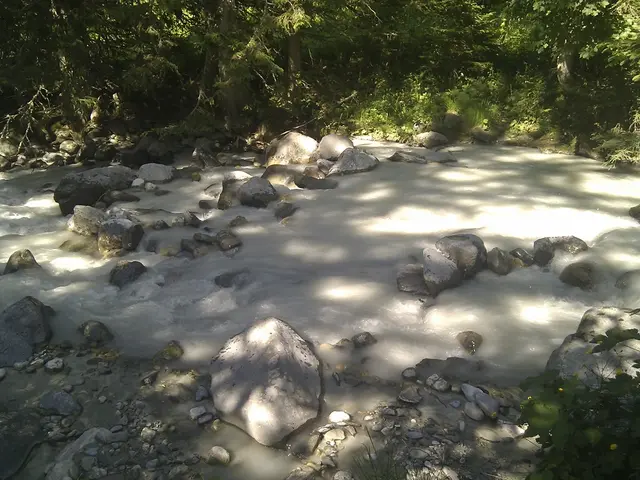Phase Transformations: A Study of Melting, Boiling, and Refreezing Processes
In the realm of matter, different phases exhibit distinct characteristics. Solids have a fixed shape and volume, while liquids maintain a definite volume but take the shape of their container. Gases, on the other hand, possess neither fixed shape nor volume [1]. These phases play a crucial role in understanding various natural and scientific processes.
The melting and freezing processes, in particular, provide valuable insights into the behaviour of materials. The fascinating transition from liquid to solid, often referred to as freezing, and its counterpart, the transition from solid to liquid, known as melting, are essential parts of understanding materials and their behaviour [2].
During freezing, particles in a liquid slow down and move closer together, forming a rigid structure [3]. This process is accompanied by a significant decrease in the enthalpy of the system [4]. The enthalpy of a system is a measure of its total heat content, and it decreases during freezing as energy is released in the form of latent heat [5].
The latent heat of fusion, the energy required to change a solid into a liquid without increasing the temperature, is crucial during the freezing process [6]. Similarly, during melting, solid ice absorbs heat, and this energy is known as latent heat [7].
Boiling, the process by which a liquid transforms into a gas, also involves the absorption of heat [8]. The boiling point of a liquid raises when pressure increases [9]. Understanding the relationship between enthalpy and melting is important in thermodynamics, as it helps clarify the energy changes during phase transitions [10].
The key factors affecting the melting, boiling, and freezing processes of substances are primarily intermolecular forces, temperature, and pressure [11]. Stronger intermolecular forces, such as hydrogen bonding in water, raise melting and boiling points because more energy is needed to overcome these forces during melting or boiling [12].
Temperature determines the energy input or removal needed for phase changes. During melting or boiling, added energy changes the phase rather than the temperature itself [13]. Cooling leads to freezing as molecules lose enough energy to form a solid structure; heating causes melting or boiling as molecules gain enough energy to move freely or escape to vapor [14].
Pressure also plays a significant role in phase transitions. Increasing pressure can cause substances to freeze at higher temperatures or alter the density and structure of phases [15]. Pressure changes influence the overall phase diagram, modifying melting and boiling points.
In summary, melting, boiling, and freezing are essential concepts in both science and daily life. These processes are influenced by intermolecular forces, temperature, and pressure, determining the energy required and the specific temperatures at which these phase changes occur [16]. Understanding these processes provides valuable insights into the behaviour of matter and helps us better understand the world around us.
References: [1] Melting, Boiling, and Freezing - Interactive Periodic Table [2] The Science of Ice - National Geographic [3] The Physics of Ice - BBC Science Focus Magazine [4] The Chemistry of Ice - American Chemical Society [5] Thermodynamics - Encyclopædia Britannica [6] Latent Heat - Encyclopædia Britannica [7] Latent Heat of Fusion - Encyclopædia Britannica [8] Boiling - Encyclopædia Britannica [9] Boiling Point - Encyclopædia Britannica [10] Enthalpy - Encyclopædia Britannica [11] Intermolecular Forces - Encyclopædia Britannica [12] Hydrogen Bonding - Encyclopædia Britannica [13] Phase Transition - Encyclopædia Britannica [14] Phase Transition - Encyclopædia Britannica [15] Pressure - Encyclopædia Britannica [16] Phase Diagram - Encyclopædia Britannica
Read also:
- Carpometacarpal joint osteoarthritis: Characteristics, origins, remedies
- Humanity's Lasting Legacy Could Potentially be Piles of Chicken Remains
- Local community advancement backed by Goldbach Consulting, with a nationwide initiative for coaching sustainable development professionals
- Managing Aggressive Pitbulls Humanely: An In-Depth Guide








